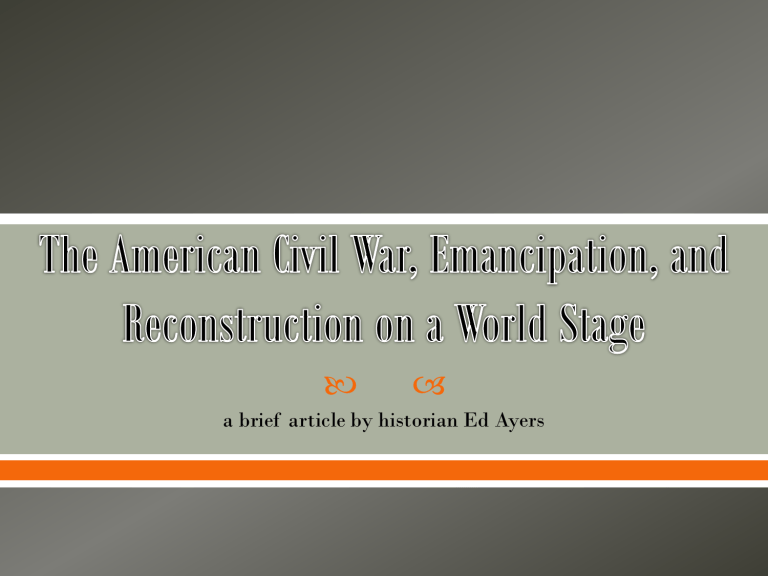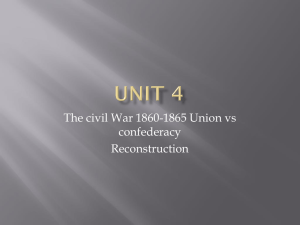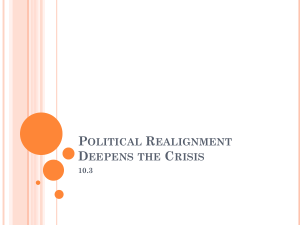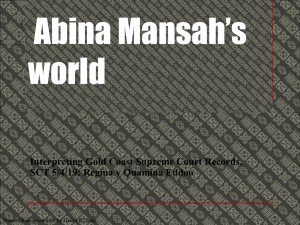Ed Ayers Civil War and Reconstruction Article - fchs

a brief article by historian Ed Ayers
Although we think of the Civil War as a domestic matter,
European nations and a global audience evaluated the United
States based on the war.
The destruction of slavery – as an economic issue and as a moral one
– was extraordinarily important to the world.
Lincoln’s Views on the Future of
Democracy
To Lincoln, the notion of secession was anathema to a functioning democracy.
Secession brought into doubt whether or not “a constitutional republic, or a democracy… can, or cannot, maintain its territorial integrity.” In other words, if the South could secede, then why wouldn’t the West – or the far West? Originally, the war was fought to address this issue exclusively.
The Southern Argument for Self-
Determination
The Southern answer to
Lincoln’s advocacy for democracy was to plea in favor of “self-determination.”
To some extent, this was simply an extension of a longstanding states rights philosophy – which went all the way back to Anti-
Federalists stalwarts. But it is probably fair to say that it was also a convenient defense to promote the institution of slavery, too.
Defining nationhood in a democratic, constitutional republic.
The future of slavery in the world – not just the United
States.
The reinvention of modern warfare for an industrialized world.
Reconstruction of an economy, and more importantly a society in the former Confederacy.
It is also important to recall that other nations did not look to the
United States as an influential world power in this period. We were a regional power at best – asserting influence over the
Western Hemisphere. Yet, as an experiment in the limits of selfgovernment and as a nation with enormous potential for growth, it is fair to note that we commanded the attention of a world audience. England and
France both considered intervention in the US Civil War as a legitimate option.
The United States was uniquely situated as a product of many World
Cultures. The Nation was born of:
European Ideas – the Enlightenment, the Reformation
The Atlantic Trade – with Europe, the Caribbean, and Africa.
African Slavery – was critical to the nation’s growth
Conquest of the Land – from Europeans and Native Americans.
Massive Immigration – from Europe, and increasingly now Asia.
By the middle of the 19 th Century, slavery was the key to the Southern Economy, and the Southern Economy was strong.
Cotton was a global commodity, and the American South dominated that market.
The factory system in the American North and throughout
England and France was dependent upon a supply of cotton which the South supplied.
“The slaves of the South were worth more than all the railroads and factories of the North and South combined; slavery was good business and shrewd investment.”
The Confederacy viewed the
Civil War as a defense of the profitable institution – and saw numerous ways to expand the system in terms of geography and innovation.
Brazil and Cuba continued slave economies long after the
United States had abandoned them.
How slavery could be changed to serve the needs of an increasingly industrial society was on the minds of many Southern businessmen.
William Walker attempted to expand slavery into Central America .
While Southerners became more devoted to defending the slave system, the greater part of Europe was abandoning the practice out of moral concerns and economic changes.
Slave revolts in Haiti made the system impossible to maintain.
The English condemned the practice – and leading
Abolitionist Societies began to influence American thought.
The Russians freed the serfs in 1863 – and had been moving towards more reforms for some time.
Abolitionism – The Liberator and English Abolitionists
The Cotton Kingdom – Slavery
Affirmed
Even as the English and to a lesser extent the French condemned slavery as morally wrong, they purchased the product of slave labor – cotton – in record amounts. The most profitable years for Southern plantation owners were the middle 19 th Century.
In the South, ideas of ethnic unity – among whites – and economic self-interest began to emerge as influential. (These
were not, in any way, exclusively regional ideas.)
The Confederacy found justification for secession in recent history – Italy, Poland, Mexico, and Greece all having gained independence in roughly analogous circumstances during the 19 th Century.
The American Revolution – and many of the most important characters in the Revolution were Southerners – was also critical to the South’s justification of their actions.
If the minority will not acquiesce, the majority must, or the Government must cease. There is no other alternative, for continuing the Government is acquiescence on one side or the other. If a minority in such a case will secede rather than acquiesce, they make a precedent which in turn will divide and ruin them, for a minority of their own will secede from them whenever a majority refuses to be controlled by such a minority. For instance, why may not any portion of a new confederacy a year or two hence arbitrarily secede again, precisely as portions of the present Union now claim to secede from it?... Plainly the central idea of secession is the essence of anarchy.
• - Abraham Lincoln, First Inaugural Address, 1861
Railroads
Telegraphs
Ironclad
Submarines
Hot Air Balloons
Modern Weaponry
Military Genius
The number of men who died in the Civil War was heretofore unknown in Europe – Southern casualties were nearly as great proportionally as the Great War.
In some ways, the modern armies were foreshadowing future horrors, but he lesson went largely unlearned. Using old tactics against new weapons created casualties and death never known at
Shiloh and Antietam.
Ulysses Grant would be slandered as a butcher of men for recognizing these realities and pressing forth nevertheless.
Both France and England were courted heavily by the Confederacy. They sought weapons, financial backing, and even military alliances. These never materialized, but it took significant pressure from the Union and moral suasion within their domestic fears to prevent it. The English were particularly critical of
Lincoln, until martyrdom saved his legacy.
When President Lincoln issued the Emancipation
Proclamation, he did so a military measure – and carefully explained his actions in the document itself. By robbing the
Confederacy of their enslaved labor and benefiting from African-
American soldiers –
Lincoln executed an effective measure in the zero-sum competition for the enslaved.
Over 200,000 formerly enslaved African-
Americans fought for the
Union during the Civil
War. The black soldiers played a decisive role in the war, and, perhaps more importantly, set a precedent for the potential oppressed people had for liberating themselves from the worst of circumstances.
What if the Confederate States of America had survived?
The enslaved population of the South would certainly have been used in coal mines, steel mills, and railroad construction – as it had been before the war started. During the war, the roles of slaves expanded dramatically.
The survival of an industrialized state based on slavery would have been contrary to all of the momentum towards greater individual rights and representation in government which had advanced over the past two hundred years or so of world history.
The goals of the
Reconstruction to create freedom for the newly emancipated African
American population were large. Property rights, citizenship, dignity, and equality before the law. The
Radical Republicans directing the
Reconstruction advocated for immediate social and economic equality for African-
Americans. Indeed, many African-American legislators and leaders participated in the process.
The Freedman’s Bureau Established – the Freedman’s Bureau not only provided formerly enslaved persons with food and shelter, it also helped to negotiate wages as the economy changed over from a slave system to a free labor market.
The 13 th Amendment – ended slavery in the United States.
The Civil Rights Act of 1866 – redefined citizenship as a national identity, asserting the power of the national government over the states.
The 14 th Amendment – provided citizenship rights to everyone born in the United States – including African-Americans born into slavery. The only exception was Native Americans.
The 15 th Amendment – gave African-American men the right to vote in national elections.
Black Codes were passed in Southern States to prevent
African-Americans from autonomy of movement, residence, or employment.
Fines and imprisonment imposed on African-Americans during the Reconstruction, allowing Southern whites to arbitrarily imprison the formerly enslaved – and forcing them to work long hours on plantations or in mines to pay off unfair fines.
Violent hate groups like the Ku Klux Klan administered vigilante justice in murderous night rides intended to frighten and terrorize African-Americans and their
Republican supporters.
African-Americans were not allowed to serve on juries or allowed access to an objective justice system.
African-Americans had little access to land ownership and were frequently manipulated in contracted labor – preventing them from obtaining economic justice.
Southerners managed to create a false storyline – that they had been humiliated by the Union and forced to endure subjugation to not only the soldiers but also their African-American neighbors.
Films like The Birth of a Nation (1915) and the revisionist Gone
With the Wind (1939) condemned the Reconstruction as a social experiment gone too far – a mistake in judgment due to the over exuberance of Radical Republican leaders.
As Southerners began to transform their economy into a more productive and industrial system, African-Americans were excluded from the most profitable aspects of the recovery. After the
Compromise of 1877,
Southerners saw Union soldiers removed from their states, and resumed the system of racism and segregation which had prevailed previously. In some ways, the circumstances
African-Americans lived in resembled the servitude of enslavement.
The systematic exclusion of African-
Americans from economic prosperity was a model for other segregated systems in other nations – South
African apartheid being the longest lasting model. There, the system of white supremacist rule extended into the 1990s
– until Nelson Mandela led a peaceful revolution to create a representative democracy.
At the same time as Reconstruction,
Americans began to project their influence into the Pacific and the world of Imperialism. Alaska was acquired, and missionaries ramped up the their work in the Pacific.
Focus on the West prompted
American settler to begin assimilation efforts on Native
Americans as well, teaching a
“dying race” about private property,
Christianity, and the virtues of
American citizenship. In short, part of the lesson learned from
Reconstruction was that it was the duty of all white Americans – in the
North and the South, to raise up – or “civilize” – non-Europeans everywhere.
Military strategy like Alfred
Thayer Mahan’s The Influence
of Sea Power Upon History, business interests, missionaries, and proponents of rigid racial hierarchies and ideologies – there was certainly no real science behind the theories – all agreed that American conquest of foreign nations would benefit the conquered.
Consider Hawaii, Guam, the
Philippines, Panama, Cuba, the reservation policy for Native
Americans, and any number of other military or economic policies to promote an
American Sphere of Influence in the world.
“The White Man’s Burden”
The railroad networks created an interdependent economy.
Financial systems provided capital to invest in innovative technology and communication inventions.
Urbanization was spurred on by mechanization, cheap immigrant labor, and improvements in transportation and communication.
Westward expansion and steady population growth secured
American claims to the West.
Mining, fuel production, and the efficient use of natural resources strengthened economic gains.
Corporations were strengthened and became more productive – expanding their reach into international markets.
During the late 1890s, the United
States adopted a foreign policy of imperialist gain, acquiring Hawaii,
Guam, Puerto Rico, a protectorate in Cuba, and most significantly the
Philippines. The Spanish-American
War – “A Splendid Little War” according to Secretary of State
John Hay – is an example of the mixed feelings Americans would feel. Acquiring Guam, and Puerto
Rico were simple enough endeavors.
However, in suppressing a revolt for independence in the Philippines, the United States would be forced to come to terms with the tragic irony of a democratic, selfgoverning nation using military force to subjugate colonies.
1920s and 1930s: The Civil
War was something which could have been avoided.
1940s and 1950s: The Civil
War was like World War II – a conflict which destroyed tyranny and promoted democracy.
2000s: The Civil War had contradictory meanings, unfulfilled hopes, and – particularly when the failed
Reconstruction is factored in
– many, many unintended consequences.
How did the experience of the Reconstruction in the
American South influence the reconstruction efforts in each of these nations? o Germany following World War II o Japan after World War II o Iraq o
Afghanistan o
Korea













